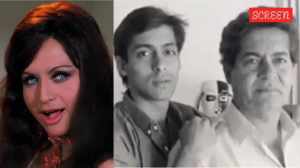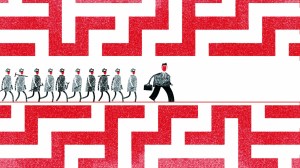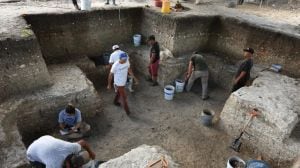TCA Raghavan’s Circles of Freedom, Friendship, Love and Loyalty joins the personal and the political in telling the story of Md Asaf Ali and the friendships that shaped his life
A new book tells the refreshing story of a lesser known freedom fighter and four people closest to him during the movement: Sarojini Naidu, Syud Hossain, Syed Mahmud and Aruna Asaf
 The history of India’s freedom struggle has seldom been seen as a story of friendships and personal ties. (Source: Amazon.in)
The history of India’s freedom struggle has seldom been seen as a story of friendships and personal ties. (Source: Amazon.in)In an especially moving scene in the first half hour in Richard Attenborough’s Gandhi (1982), CF Andrews meets the then-emerging leader of the Indian National Movement, who is awaiting trial for his role in the Champaran Satyagraha. Andrews had been asked by the British government to be a part of the team to investigate the mistreatment of indentured labourers in Fiji. But the former Anglican missionary’s heart is clearly in Indian politics. Gandhi, however, persuades him to become part of the Fiji panel. To a disappointed Andrews, he says, “You will always be with us”. The friendship between the (not-yet) Mahatma and the evangelist educator-turned-Indophile is one of the lesser-known stories of the Indian freedom movement. It, perhaps, required a film to convey the warmth between the two. Traditional historical scholarship rarely conveys the depth of such emotions.
The history of India’s freedom struggle has seldom been seen as a story of friendships and personal ties. Diplomat-historian TCA Raghavan’s Circles of Freedom, Friendship, Love and Loyalty in The Indian Freedom Struggle (Rs 799, Juggernaut) is, therefore, a refreshing foray into an area that has been the preserve of a handful of historian-biographers. His work is also noteworthy because it’s about a relatively lesser-known figure of the national movement — Mohammad Asaf Ali — and four people who touched his life: Sarojini Naidu, Syud Hossain, Syed Mahmud and Aruna Asaf, his wife, who took a different political path. The couple grew apart, yet Aruna and Asaf cared for each other in their own way. Circles of Freedom takes us through momentous episodes of the freedom struggle, from the Khilafat Movement to the Partition. Gandhi, Jinnah, Nehru, Sardar Vallabhbhai Patel, brothers Mohammad Ali and Shaukat Ali, and Maulana Azad make compelling appearances. So does MA Ansari, who till his death in 1936, was “the go-to-physician for many leaders of the national movement”.
Naidu’s sister Mrinalini Chattopadhyay introduced the poet-nationalist, who had been published with some acclaim in England, to Asaf Ali, then a young barrister in England. Naidu had a circle of friends in England, which soon included Hossain, a friend of Asaf from his student days. In her letters to her children, Naidu referred to Asaf and Hossain as part of her “special group of friends”. Being in Naidu’s circle also meant developing ties beyond the literary and the cultural. To begin with, it lead to “a closer acquaintance with another star of the Indian diaspora, Muhammad Ali Jinnah”.
The experiences in London also led Asaf to gravitate towards nationalists in India. A second stint in England, where he spent most of his time with Naidu and Hossain, cured the Anglophile of his “English fever”. “Friendships with Mohammad Ali and Ansari had widened his horizons” and the time he spent with Naidu in London “opened them up further”.
Asaf received his early higher education at Delhi’s St Stephen’s College, where Andrews was amongst his teachers. A scholarship to a friend to study in London spurred the young student’s ambition for a career in law, and then to the ICS. A friend of his father, an ‘Uncle’, stepped in and made it possible for Asaf to go to England and study for a career at the Bar or as a civil servant.
Among the many reasons that make Raghavan’s account interesting is that it also carries insights into the subtle operations of colonialism. As Asaf was to realise later, the arrangement with ‘Uncle’ was more transactional than generosity towards a friend’s son. By his second stint in England, Asaf was no longer the impressionable young man who had stepped out of his home nation. The young nationalist was now aware that his conversations about his fellows with ‘Uncle’ were actually giving away information to the colonial intelligence services.
After disembarking in Bombay, Asaf’s first port of call was Hyderabad to meet Naidu. Historical accounts have bestowed her with a mystique. A firebrand nationalist, poet, a champion of Hindu-Muslim unity. But there is very little we know of her family life. Her letters to her children, writes Raghavan, show her “as a fond and devoted mother and wife and at the same time someone who took it as a given that she was going to play more than these roles”. “There is also (a) veil,” he notes, that makes “ family and personal life opaque for both the contemporary observer and historical excavator”.
In detailing the other protagonist of his story, Syed Mahmud, Raghavan brings out another facet of Naidu. Unlike Asaf Ali, who viewed her as an elder sister, Mahmud was deeply infatuated with Naidu. As the more mature and older woman, she not only nudges Mahmud to temper his feelings, but also arranges to get the young man, almost always in ill-health, treated by her physician husband. The friendships she forged, writes Raghavan, should also be seen in the larger context of Naidu’s belief that Hindus and Muslims would make connections “which were more than simply political”.
However, she was disapproving when Asaf, nearly 40, fell in “love with a young Bengalee (Aruna) girl of 18 whom he met for two days and is very keen to marry”. The objection, writes Raghavan, could be because of the age difference between the two and the chequered trysts of her friends such as Jinnah and Ruttie Petit with inter-religious union. As it turned out, Aruna and Asaf, were to diverge politically and in life — a turn of events that impacted “husband” and “wife” very differently.
Raghavan joins the dots between the personal and the political or social with rare empathy. In doing so, he also nudges the reader to draw links between the past and the present. This makes Circle of Freedom a compelling read for anyone who cherishes history and loves a story well-told.






- 01
- 02
- 03
- 04
- 05

























